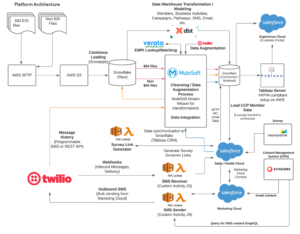Principles of Technology Solution Delivery: How a Healthcare Tech Company Amplified its Technology Solutions

“Think left and think right and think low and think high. Oh, the thinks you can think up if only you try!” ― Dr. Seuss, “Oh, the Thinks You Can Think”
We completely agree with Dr. Seuss because we do a lot of thinking here at Kenway. Sometimes it’s strategic thinking, and other times it’s contemplating new ideas around technology. It’s thinking about our clients’ challenges and identifying the right capabilities and services to resolve them.
We also kicked off our previous blog post with a Dr. Seuss quote about the importance of staying curious and keep learning. We shared how Kenway Consulting is helping a healthcare patient engagement company and our key learnings from the project around Enterprise Program Leadership.
Now we’ll build on those learnings and turn to the technology side of the project – considerations made and lessons learned while building the technology platform itself (pictured below). And as Dr. Seuss says, this one gave us a lot to think about, and we believe it will give you a lot to think about too.
IMPLEMENTING A NEW ENGAGEMENT PLATFORM
The healthcare technology company we will be diving into in this blog partners with leading health insurance companies. It supports them by growing health plan members’ engagement to reduce healthcare costs, improve quality measures, and increase overall health outcomes. The company decided to re-platform its engagement product and scale its user base to achieve these goals.
The client was challenged to implement an improved, automated platform that would scale with it as it grew and needed it done quickly. Given the accelerated timeline and complexity of the project, the company turned to Kenway for its capabilities around Enterprise Program Leadership, Technology Solution Delivery, and Information Insight.
The healthcare company’s technology issues were just as challenging as its Enterprise Program Management difficulties. The client used an inefficient, costly legacy platform and required manual efforts to perform basic, repeatable activities. Kenway worked with the client to move them to the Salesforce platform to better meet the needs of their business processes.
Salesforce allows the client to interact with health plan members in more than 25 languages via SMS, email, phone call, and direct mail. This two-way communication occurs through a series of multimodal touchpoints comprising “pathways.” Each pathway has a unique objective, such as helping a member schedule an annual wellness visit.
THINKING ABOUT TECHNOLOGY SOLUTIONS FOR PRESENT AND FUTURE NEEDS
Kenway’s Technology Solution Delivery capabilities guide and support organizations on their technology transformation journey. We design and deliver a customized approach across these four core services:
- IT Strategy: We maximize value by aligning IT objectives with business strategies, setting direction to drive business goals, and minimizing ongoing support costs.
- Architecture & Design: Kenway provides recommendations, roadmaps, technical design documents, and use case evaluations while aligning with enterprise architecture and IT strategy.
- Custom Development: Kenway develops solutions to meet business objectives while aligning with enterprise IT strategy and focusing on security, scalability, and optimized performance.
- Enterprise Applications & Solutions: From packaged solutions to integrations and upgrades, our proven methodologies can support the successful implementation of enterprise solutions.
Kenway leveraged these core services to ensure the healthcare company was driving business benefits to support immediate needs while also providing the flexibility to scale to future demands. Here we dive deeper into two of those needs, including the lessons learned that could apply to your enterprise.
BUILD VERSUS BUY
In our previous blog post, we shared the importance of doing your due diligence on vendors to ensure they have the capabilities to meet your immediate and long-term needs for software. But there is an essential step before vendor selection where enterprises must decide whether they need a vendor or if they can accomplish their goals internally.
Healthcare organizations often confront a fork in the road where they must decide whether to take the path toward building or buying. The decision can have ramifications from a perspective of costs, ROI, and scalability. At Kenway, we advise our clients that when the software solution is very custom or has a high volume of complex requirements, then that is a case for building.
Let’s take an example of build versus buy from our healthcare company. The company conducts outreach to its members via snail mail and works with a direct mail partner to send out mailers. This was a decision where the company chose to buy because the vendor had more expertise with the mail system than the company had available internally.
Another type of outreach to members is a health risk assessment survey. The healthcare company partners with a vendor to send these surveys electronically to members. It chose to buy this service because the vendor can send the surveys at scale and populate them with specific data requirements based on members’ attributes.
As a follow-up to the survey, the member, their primary care physician, and the healthcare plan provider each receive a summary by mail of the survey results and an individualized care plan with actions to take based on health issues or risks. However, most healthcare plans do not want snail mail and prefer a Word document in editable format. The hitch is that most direct mail vendors do not support Word docs.
So, this would be a case for building out a system internally since the Word doc capability is likely unavailable via a vendor. By keeping ‘the build,’ the healthcare company could leverage the skillsets of its internal teams and maintain control, make changes quickly, and lessen its risks.
These are questions to ask when weighing the pros and cons of build versus buy:
- Do you have the internal capabilities and skillsets available to build internally?
- If so, what is your organization’s appetite to support the project for the long term?
- If you decide to buy, will you need to switch to other vendors in the future as you scale?
- If you buy a custom solution, do your risks increase if the vendor cannot support the solution’s features in years to come?
AUTOMATION VERSUS MANUAL PROCESSES
Our healthcare company client was struggling with a classic case of manual process woes. It uses an internal call center with agents to route its member cases. But there was a limit on the number of cases the agents could route automatically. This resulted in the necessary intervention of two call center operating managers who had to take 10 hours per week (520 hours per year!) to manually click and drag to assign cases to the call center agents.
The lesson learned was that organizations should work towards minimizing the amount of repeatable, non-value-adding manual work by their employees. By switching more tasks to automation, companies can allow their teams to use their unique skillsets on tasks that require a human touch.
Taking the time upfront to prioritize automating as much of the business as possible will help enterprises with scalability and profitability. Because if organizations don’t identify the inefficiencies of manual processes existing at launch, those inefficiencies will only greatly magnify as the business scales. The issues will reach a point where they will become much harder to fix and lead to increased costs to rein them in.
Take, for example, the community health guides that the healthcare company uses. The guides communicate with members via phone, text, and email. Some of these interactions are done manually, and others with Salesforce automation. In the case of phone calls, the guide would read from a script and click through a series of screens in Salesforce based on the member’s responses. The quicker the guide can wrap up the call, the more efficient the system. At launch, the system was designed to handle future surges in call volume to prevent any limitations that may arise.
Ready to equip you and your team with the knowledge you need to successfully integrate technology solutions into your organization? Get more insight by scrolling through our blog. Or, if you’re ready to talk to one of our experts about reaching company goals, connect with us to learn how we can help with your technology solution needs.








